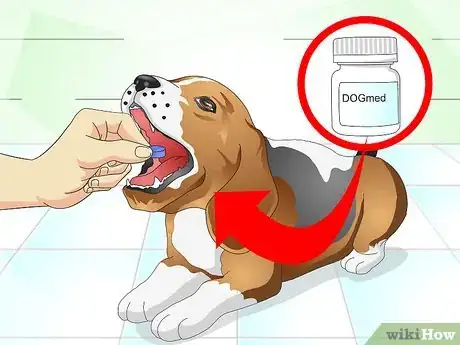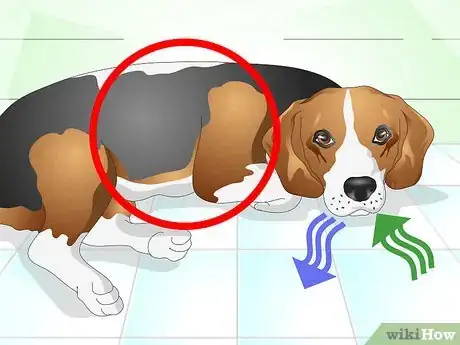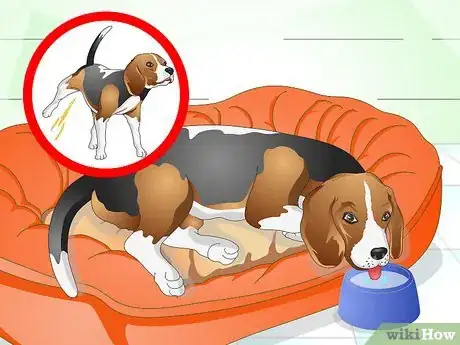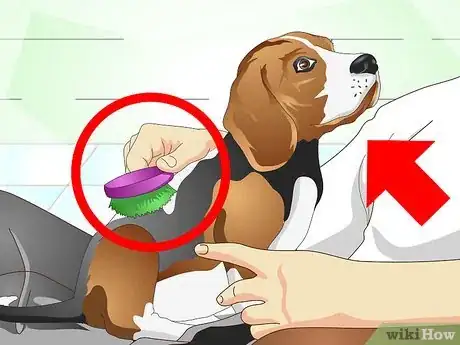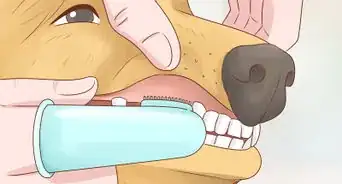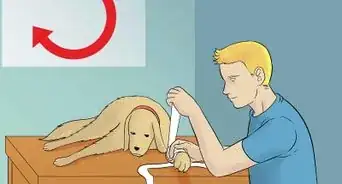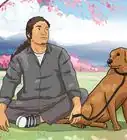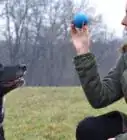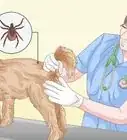This article was co-authored by Belgin Altundag and by wikiHow staff writer, Jessica Gibson. Belgin Altundag is a Certified Dog Trainer and the Owner of Happy Doggies Day Care/Day Camp in West Hollywood, California. A passionate animal lover, Belgin is knowledgeable about multiple training styles, including obedience training, problem-solving, activity training, and behavior modification. In addition to being an Animal Behavior College’s Certified Dog Trainer (ABCDT), Belgin has also completed the Training Cesar's Way Fundamentals of Dog Behavior and Training Programs 1 and 2 and is certified by the American Red Cross in Cat and Dog First-Aid.
There are 7 references cited in this article, which can be found at the bottom of the page.
This article has been viewed 77,194 times.
At some point, your dog will probably get sick. Once you've taken him to the veterinarian for an exam, bring him home to care for him. Your veterinarian may give you medication to administer and tell you how to monitor your dog's health. Beyond watching for signs of improvement, you'll also need to care for your dog and make him comfortable during his recovery. This will reassure him and could speed up the healing process.
Steps
Monitoring Your Dog's Health
-
1Give your dog medication. Follow your veterinarian's dosing instructions to make sure your dog gets his medication regularly. To help you remember, create a simple tick box chart and note when you've give the medicine. If you need to give medication twice a day, it's most effective to give each dosage at twelve hour intervals. For example, give one dose at 8 am and the other at 8 pm. You should also ask if the medication needs to be taken with meals.[1]
- Charting when you medicate can be especially helpful if you're sharing nursing duties with a partner. This way, you know if the other person has treated the dog.
-
2Pay attention to your dog's attitude. A dog's demeanor says a lot about how he's physically feeling. You'll need to make sure his health is gradually improving and responding to treatment. For example, he should begin to pay attention to you, wag his tail, and get up to greet you. It's also a good sign if he perks up and starts asking for food.
- If you notice your dog becoming less interactive (just lying still), he may be getting worse and need medical attention.[2]
Advertisement -
3Track how often your dog vomits. If he is vomiting and not drinking then you need to make sure he doesn't become dehydrated. After he vomits, withhold food for 12 to 24 hours, but keep offering water.[3] If he is unable to keep fluids down either, immediately contact the veterinarian.
- Be prepared to tell your vet how many times in a specific span of time your dog has vomited. However, if he's vomited just once and resumed eating and drinking again, it's probably no cause for alarm.[4]
-
4Look for diarrhea. You'll need to follow your dog into the yard to see what he eliminates. While a little diarrhea might be expected with your dog's illness, contact the vet if you notice large volumes of watery diarrhea.[5] You should also check his stools for blood (another reason to see the vet). Your dog may need intensive supportive care like intravenous fluids.[6]
- Even if your dog has a little diarrhea, be sure to offer lots of fluid. Ensure that he's getting more fluid than he's losing.
-
5Notice signs of dehydration. Look at your dog's gums, which should be pink and moist. If they're dry feeling, he may be dehydrated. You can also lift up the scruff of your dog's neck and let it drop. If hydrated, it should immediately return to the original position. If dehydrated, the skin will slowly fall back over the course of a few seconds, rather than snap back. Dehydration in a sick dog is a cause for concern, so take your dog to the vet.
- If you notice your dog is dehydrated, you can try offering fluids. If he takes them, continue to watch for dehydration. However, if he can't keep fluids down, get immediate medical care. Your dog may need medication of intravenous fluids to prevent organ damage.[7]
-
6Watch your dog's breathing. Your dog's breathing can tell you a lot about how he's feeling. If he's in pain, he may breathe heavily or pant. Coughing and heavy breathing are signs of a chest infection. You should also check your dog's gums if his breathing causes exaggerated chest movements. The gums should be pink and healthy, but if they look pale or tinged blue, contact the vet. Your dog might not be getting enough oxygen and could be in respiratory distress.[8]
- Count how many breaths your dog takes a minute (normal is 20 - 30) and keep an hourly record. If the rate steadily increases, his condition is deteriorated and you need to contact the vet.[9]
Caring For a Sick Dog
-
1Make the dog comfortable.[10] Your sick dog should have somewhere he can lie down and rest. He might like a padded bed (like a bean bag) or sheepskin rug that's soft and supportive. Set up a resting area in a quiet spot so he's not disturbed. If your dog is small or shaking and shivering, cover him with a blanket or offer a hot water bottle wrapped in a towel (so it doesn't scald his skin).
- If he is liable to vomit or dribble urine, you may want to lay a puppy pad over the bed to soak up any bodily fluids. Puppy pads also prevent your dog from lying in his mess.
-
2Position your dog so that they're lying comfortably. Your dog should change positions regularly if he's not moving around much. To prevent pressure sores, turn your dog to rest on his opposite side every hour, if he's not sleeping. Mix vinegar and salt in a bowl and wet a sponge with your makeshift cleaning solution. Then, proceed to the following steps.
-
3Offer water and regular toilet breaks. If your dog is allowed to drink, make sure that he has a water bowl within reach so that he can lap without getting up. It may be a good idea to place several water bowls around the house. This can remind him to drink and prevent dehydration. If your dog is staying hydrated, you'll also want to take him out for regular toilet breaks, such as every four hours.
- If your dog has diarrhea, he should be able to get to a toilet area quickly, especially if he can't make it outside. Ensure he has a flap, leave a door open, or put puppy pads down so he can easily eliminate without feeling guilty.
-
4Feed your dog. If your dog has vomited, don't feed him anything for 12 to 24 hours. This will give his stomach a chance to rest.[11] When he's ready to eat, feed him smaller meals frequently. You might want to divide his daily ration into six smaller portions, feeding them every two or three hours throughout the day. If he's not eating well, try warming the food slightly and hand feed him. Remember to take your dog out for a toilet break after eating.
- Your veterinarian may suggest a special diet for your sick dog. For example, dogs with sickness or diarrhea should eat a bland, easy to digest diet like cooked chicken breast or white fish with boiled white rice.
-
5Keep your dog clean. Your sick dog may soil himself with urine or feces. Not only will this make him uncomfortable, but the urine can burn the skin (urine scald). If he does soil himself, give him a blanket bath. Soak a cloth in clean water and wash the fur, refreshing and rinsing it in clean water until the cloth comes away clean. If he's constantly dribbling urine, apply a layer of petroleum jelly to the skin of his belly and be sure to wash the area regularly.
- If you're using them, remember to change soiled puppy pads for fresh ones.
- Your dog probably won't groom himself often while he's sick. Use balls of damp cotton wool to keep his eyes clean and free of discharge.
-
6Reassure your dog. It's understandable that your dog may feel vulnerable when he's sick. If you act calmly and quiet around your dog, this can reassure him. Stroke him gently to relax him. When he appears to be improving, brush or groom him to improve his mood and self-esteem.
- Your dog should be in a warm, comfortable place where he's able to get rest. Check on him periodically to let him know you're around and watching out for him.
Expert Q&A
-
QuestionHow can I make my dog feel better when sick?
 Belgin AltundagBelgin Altundag is a Certified Dog Trainer and the Owner of Happy Doggies Day Care/Day Camp in West Hollywood, California. A passionate animal lover, Belgin is knowledgeable about multiple training styles, including obedience training, problem-solving, activity training, and behavior modification. In addition to being an Animal Behavior College’s Certified Dog Trainer (ABCDT), Belgin has also completed the Training Cesar's Way Fundamentals of Dog Behavior and Training Programs 1 and 2 and is certified by the American Red Cross in Cat and Dog First-Aid.
Belgin AltundagBelgin Altundag is a Certified Dog Trainer and the Owner of Happy Doggies Day Care/Day Camp in West Hollywood, California. A passionate animal lover, Belgin is knowledgeable about multiple training styles, including obedience training, problem-solving, activity training, and behavior modification. In addition to being an Animal Behavior College’s Certified Dog Trainer (ABCDT), Belgin has also completed the Training Cesar's Way Fundamentals of Dog Behavior and Training Programs 1 and 2 and is certified by the American Red Cross in Cat and Dog First-Aid.
Certified Dog Trainer It really depends on the diagnostic made by a certified veterinarian. It also depends on the animal fitness level. You may need to supervise him constantly and stay on top of the disease to know what to do in an emergency.
It really depends on the diagnostic made by a certified veterinarian. It also depends on the animal fitness level. You may need to supervise him constantly and stay on top of the disease to know what to do in an emergency. -
QuestionWhat should I do if my dog is not feeling well?
 Belgin AltundagBelgin Altundag is a Certified Dog Trainer and the Owner of Happy Doggies Day Care/Day Camp in West Hollywood, California. A passionate animal lover, Belgin is knowledgeable about multiple training styles, including obedience training, problem-solving, activity training, and behavior modification. In addition to being an Animal Behavior College’s Certified Dog Trainer (ABCDT), Belgin has also completed the Training Cesar's Way Fundamentals of Dog Behavior and Training Programs 1 and 2 and is certified by the American Red Cross in Cat and Dog First-Aid.
Belgin AltundagBelgin Altundag is a Certified Dog Trainer and the Owner of Happy Doggies Day Care/Day Camp in West Hollywood, California. A passionate animal lover, Belgin is knowledgeable about multiple training styles, including obedience training, problem-solving, activity training, and behavior modification. In addition to being an Animal Behavior College’s Certified Dog Trainer (ABCDT), Belgin has also completed the Training Cesar's Way Fundamentals of Dog Behavior and Training Programs 1 and 2 and is certified by the American Red Cross in Cat and Dog First-Aid.
Certified Dog Trainer Monitor the dog and make it's eating and drinking water. Pay close attention to its feces as well. If the poop is watery or have blood, have it checked by a veterinarian, as the dog may need specialized care.
Monitor the dog and make it's eating and drinking water. Pay close attention to its feces as well. If the poop is watery or have blood, have it checked by a veterinarian, as the dog may need specialized care. -
QuestionMy dog was on an IV for dehydration yesterday, and now today he won't drink. Any suggestions?
 Pippa Elliott, MRCVSDr. Elliott, BVMS, MRCVS is a veterinarian with over 30 years of experience in veterinary surgery and companion animal practice. She graduated from the University of Glasgow in 1987 with a degree in veterinary medicine and surgery. She has worked at the same animal clinic in her hometown for over 20 years.
Pippa Elliott, MRCVSDr. Elliott, BVMS, MRCVS is a veterinarian with over 30 years of experience in veterinary surgery and companion animal practice. She graduated from the University of Glasgow in 1987 with a degree in veterinary medicine and surgery. She has worked at the same animal clinic in her hometown for over 20 years.
Veterinarian IV fluids are an extremely efficient way of hydrating an animal. If he came off the drip yesterday, it's likely he's so well-hydrated today that he doesn't feel thirsty, so refuses to drink. Don't panic, just make sure he has easy access to clean drinking water so that when he's ready, he can.
IV fluids are an extremely efficient way of hydrating an animal. If he came off the drip yesterday, it's likely he's so well-hydrated today that he doesn't feel thirsty, so refuses to drink. Don't panic, just make sure he has easy access to clean drinking water so that when he's ready, he can.
References
- ↑ http://www.vetstreet.com/our-pet-experts/what-every-good-pet-owner-should-know-about-heartworm-prevention
- ↑ http://pets.webmd.com/features/pet-symptoms-6-signs-illness-dog-cat?page=3
- ↑ BSAVA Manual of Animal Nursing. BSAVA publications
- ↑ https://www.aspca.org/pet-care/dog-care/vomiting
- ↑ Belgin Altundag. Certified Dog Trainer. Expert Interview. 11 August 2021
- ↑ https://www.aspca.org/pet-care/dog-care/diarrhea
- ↑ BSAVA Manual of Animal Nursing. BSAVA publications
- ↑ BSAVA Manual of Animal Nursing. BSAVA publications
- ↑ BSAVA Manual of Animal Nursing. BSAVA publications
- ↑ Belgin Altundag. Certified Dog Trainer. Expert Interview. 11 August 2021
- ↑ https://www.bluecross.org.uk/pet-advice/caring-your-sick-dog
About This Article
To nurse a dog when it’s sick, give it a soft, quiet resting area, such as a bean bag chair or dog bed covered in blankets. Keep a water bowl near your dog’s resting area so it doesn’t have to go far to get a drink. If your dog has been vomiting, don’t offer it any food for 12 to 24 hours. When it’s ready to eat, feed your dog smaller meals more frequently to avoid irritating its stomach. If your dog can’t hold down any fluids, has diarrhea for more than 24 hours, is listless, or is having trouble breathing, call your veterinarian. For more tips from our Veterinary co-author, including how to notice the signs of dehydration in your dog, keep reading!
